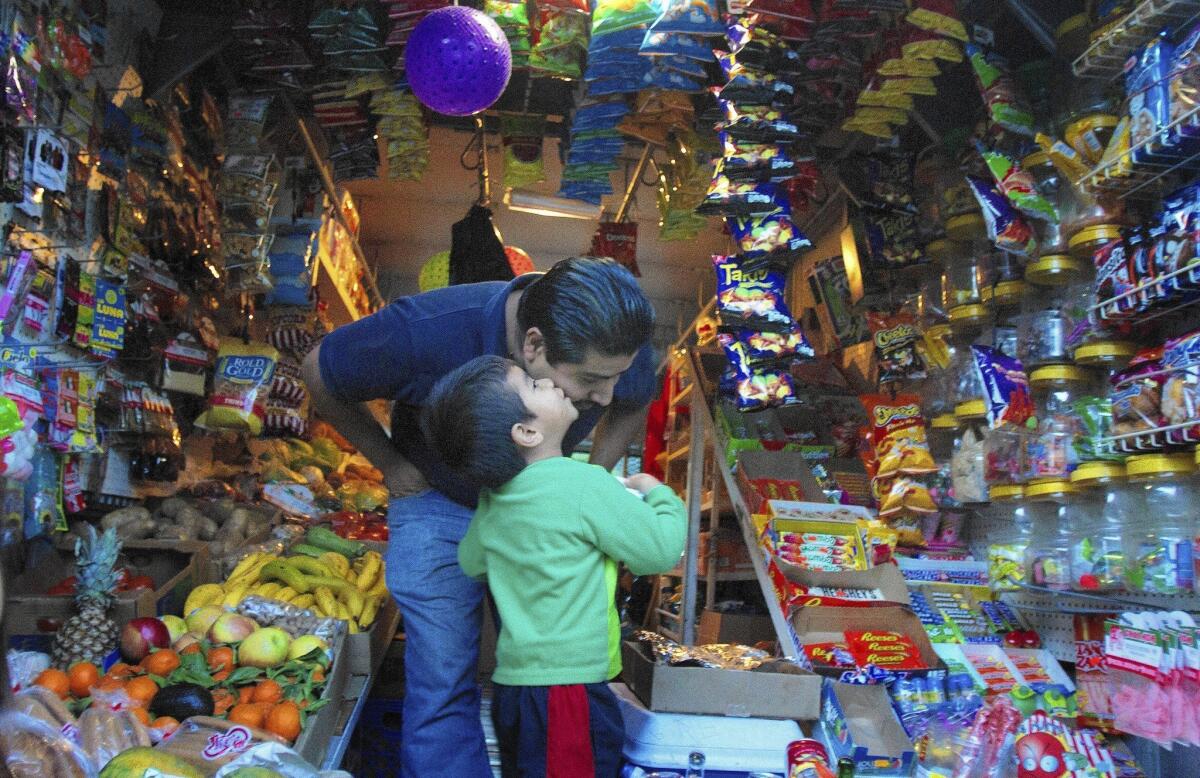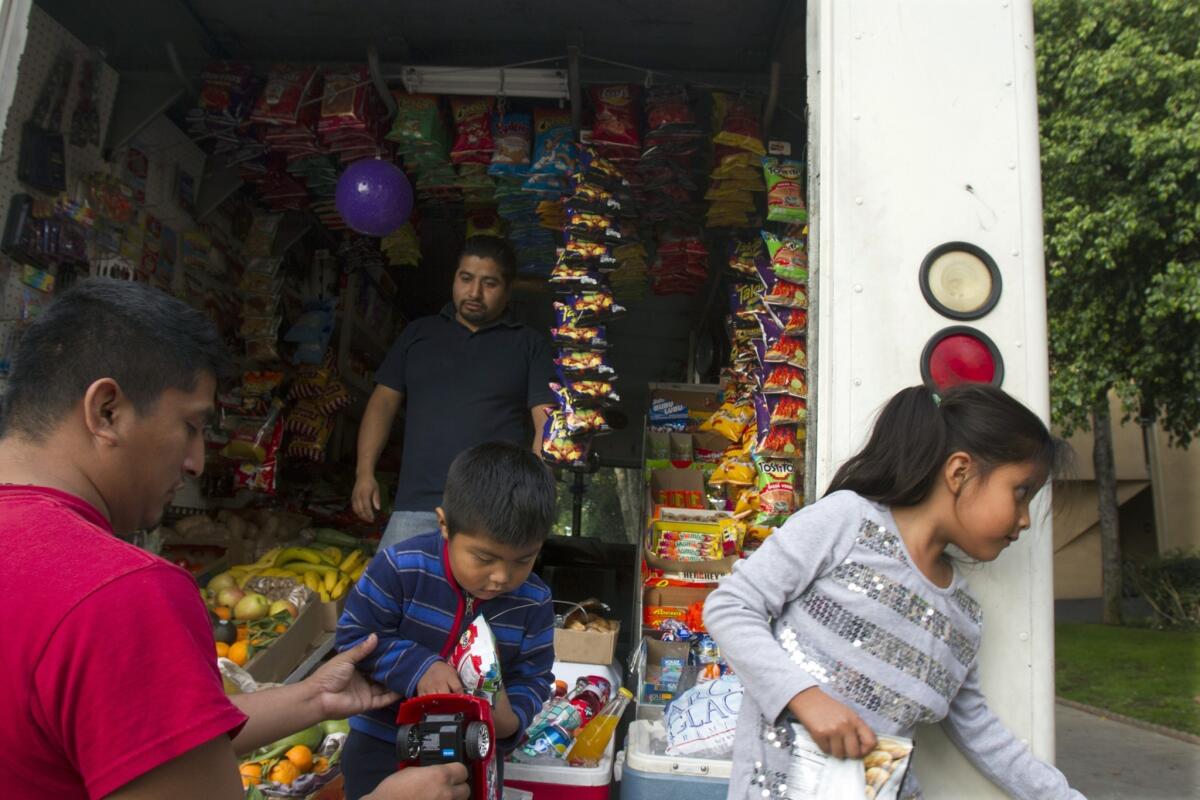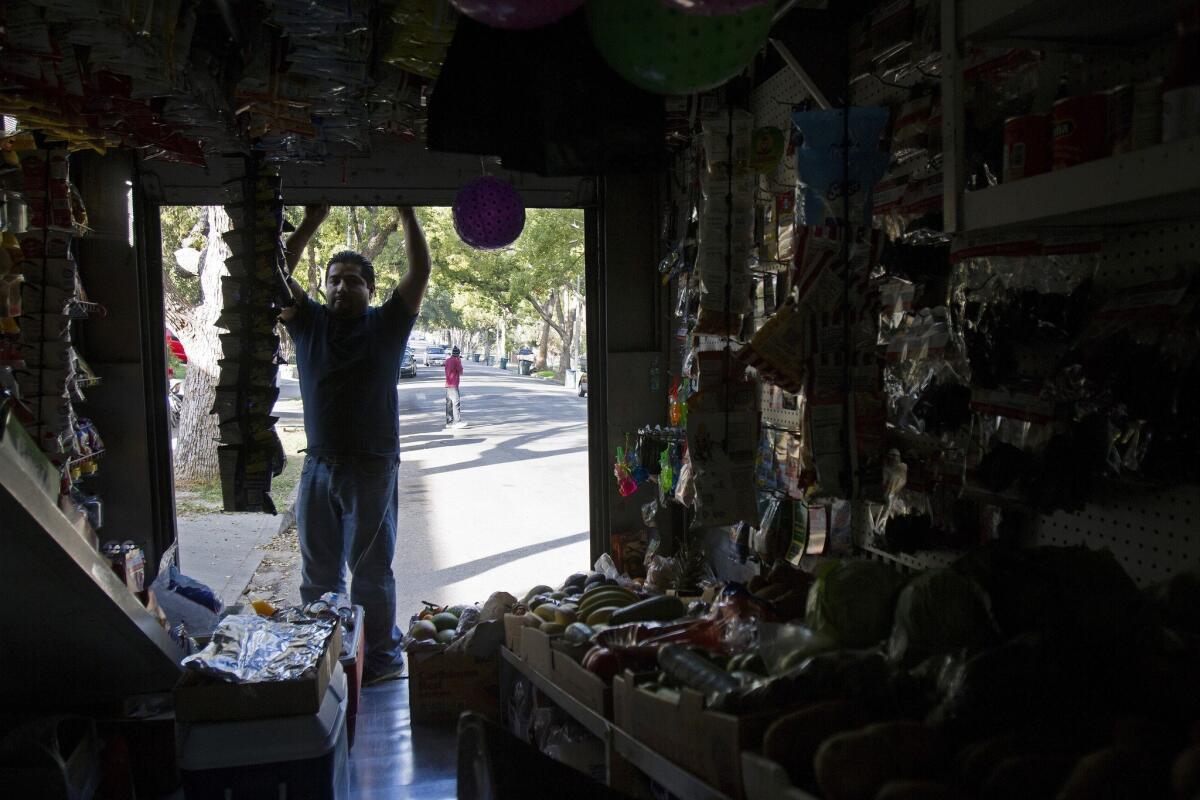Produce trucks a slice of home for Latino immigrants

Offering household sundries as well as fresh produce, an even more cherished commodity they provide is a public meeting spot like the plaza.
- Share via
Benjamin Cruz's signature honk — three quick toots and a long beep — announces his arrival on a north Pasadena street. A woman in fur-lined slippers shuffles toward the open back of his boxy white truck and peers into a colorful splash of groceries and sundries. Her young daughter, Hanna, trails along, giggling and chasing a skittish Chihuahua.
There's an ease of familiarity and ritual as Guadalupe Parra chats in Spanish about the dog's antics and what Parra needs this morning. Cruz pulls items from the bulge of merchandise around him — a roll of toilet paper off the top shelf, a few zucchinis from a cardboard crate, an avocado, a Coke can pulled out of a cooler filled with ice.
When Cruz teasingly asks 4-year-old Hanna if she wants something, she peels her face away from the dog's snout, points up toward a bag of cotton candy and squeals, "Algodon!" (cotton). As they drift away, Cruz says he'll see them soon: "Sometimes they come three or four times a day."
Cruz moves slowly down the street with the back door of his rolling convenience store open, columns of Flamin' Hot Cheetos and Cheddar & Sour Cream Ruffles swinging back and forth.
When he stops, the sidewalk and street around his truck become an open-air market, with customers pausing to catch up with one another and with Cruz, 33, goateed, with gelled-back hair and wearing a polo shirt and jeans.
A woman with a stroller buys tomatoes, and another walking by recognizes her, stops and says hello to her and her child, and the two walk away together pushing the stroller.

Approximately 600 trucks like Cruz's are licensed in Los Angeles and Orange counties, plying Latino neighborhoods from Van Nuys to Santa Ana. Unlike most food trucks, they don't serve hot meals on crowded city streets to urbanites on their lunch breaks. Instead, these trucks deliver produce, sweets and little household necessities to thousands of doorsteps each day.

Cruz sells to customers during the after-school rush in Pasadena. More photos
As they mosey along residential roads, they also provide threads of community life and ethnic commerce that bind immigrants to the customs of their homelands.
Though taco trucks also got their start in these communities, those have long since been appropriated by hipster culture to sell kimchi quesadillas and bacon-wrapped hot dogs in every corner of Southern California.
But produce trucks, at least for now, remain a contained and authentic part of the migrant experience, says Mark Vallianatos, who has studied street vending as policy director of Occidental College's Urban & Environmental Policy Institute.
"The produce truck is the piece that's kind of invisible," Vallianatos said.
That blurring of public and private space is a hallmark of Latino neighborhoods in the United States, says James Rojas, an urban planner and Latino expert in Los Angeles.
I like my job, because I don't like to work.”— Benjamin Cruz
"A lot of Latinos come from small towns in Latin America and Mexico where the plaza plays a really important part in their lives," he said. "So the whole idea is: How do you create that kind of social space in America?"
Cruz moved from Mexico in 2001, doing odd jobs for several years before he began driving the truck, owned by his sister, two years ago. There's competition in the area from a handful of other produce trucks.
"We each have our own streets," says Cruz, who squints when he smiles, so the grin seems to consume his face. "There's a respect for your space."
He rises in north Pasadena at 6 a.m., downs a cup of coffee and heads to the downtown produce mart to pick up fruit and vegetables. Beating the worst rush-hour traffic, he's back home and ready to begin his route by 9 a.m.
"I like my job," he says, shrugging. He then adds with a laugh, "Because I don't like to work."

Elementary- and middle-schoolers pour out of a bus on Maple Street. It's 3:30 p.m., and Cruz has traveled a mile south to this spot to catch the after-school rush. The kids' backpacks bounce as they run toward his truck. Their chatter drowns out the whoosh of cars on the nearby 210 Freeway.
Cruz trades bills for snacks as the crush of young arms reaches toward him, like fans trying to touch a rock star on stage.
He lingers here about an hour, twice as long as his typical stops.
Cities across the Southland have responded to concerns about congestion and safety by regulating trucks in various ways, restricting the hours they can operate and how long they can stay in one spot. In Pasadena, Cruz can drive only between 8 a.m. and 6 p.m. and must move 500 feet every 60 minutes.

Cruz closes his truck before heading to another location in his neighborhood. He starts his workday by heading to the downtown L.A. produce mart early enough to get back to Pasadena to begin his rounds at 9 a.m. More photos
More sweeping efforts at regulating food trucks have tended to fail. A Santa Ana proposal to create concrete parkways for trucks between the sidewalk and the streets was scrapped in 2005 amid opposition.
Many cities and advocates for immigrants see a benefit to the food trucks. They provide a handy source of groceries for residents in urban food deserts — neighborhoods with no ready access to fresh produce and food — that numerous studies have found are more prevalent in Latino and black communities than elsewhere.
Many of Cruz's stops are a mile or more from the nearest grocery store. Without a car, that's a big distance for residents to haul heavy bags. "For some people, a mile could [feel like] 10 miles," says Michael Prelip, professor in the UCLA Fielding School of Public Health.
By 4 p.m., the school crowd is gone, but Cruz stays. A man in a navy blue work uniform comes out of his building to get a loaf of bread. A girl just home from school buys limes.
Diffused afternoon light glows through the trees overhead, and Cruz leaves his post near the bus stop to head back to his starting street. He drives less than a block, then pauses: beep-beep-beep-beeeeep.
Almost immediately, a balding, middle-aged man walks out of the apartment complex across the street.
"I thought you might be here," Cruz says. He sells him a potato and a white onion, and drives off.

If someone could figure out how to make it hip and cool, you'd probably have them everywhere.”— James Rojas
At 5:15 p.m., Cruz has returned to where he began his day. It's dark, and he sits under a small light in his truck that illuminates his groceries.
Hanna, the girl who chose cotton candy early in the day, is carried up the sidewalk to the truck, this time by her father. He buys vegetables and a small bag of marshmallows. Hanna, perched on her father's hip, waves to Cruz as they head into their house.
Urban planner Rojas thinks the homey, ethnic produce truck could be ready for a makeover and new popularity, particularly among young, urban adults who have embraced community-building and the food truck craze.
"If someone could figure out how to make it hip and cool, you'd probably have them everywhere," Rojas said. "But people don't really want to buy bananas and apples after the club at 2 o'clock in the morning in Hollywood."
By 6 p.m., Cruz is closing up. He's had about 30 customers and brought in about $100, about half of it profit. He looks tired, resting his cheek on his fist and sitting on a crate in his truck. Then he puts on a sweat shirt and zips it up.
He parks the truck outside his house, turns off the light and pulls down the grate.
Follow Soumya Karlamangla(@skarlamangla) on Twitter
Sign up for Essential California
The most important California stories and recommendations in your inbox every morning.
You may occasionally receive promotional content from the Los Angeles Times.










